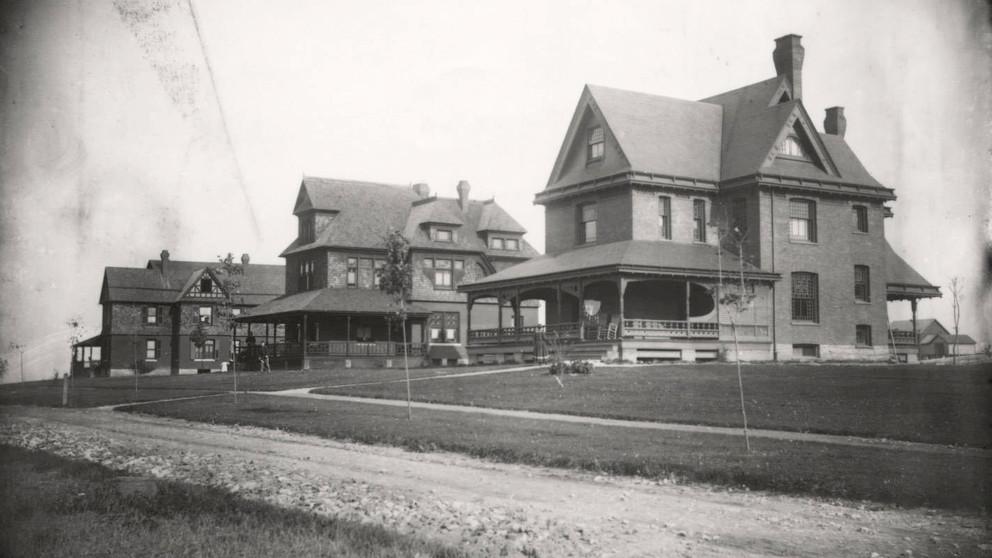In the late 19th and early 20th centuries, Penn State built on-campus cottages to house faculty members. In the years since, the cottages have served many purposes and three still fulfill important roles on the campus.
During Penn State’s early years, the borough of State College did not have enough housing for all college faculty. Cottages were built on campus to make up for the shortfall. Oak Cottage, the earliest, was built in 1857 for William G. Waring, as he oversaw the construction of Old Main and the laying out of the grounds.
Most of the cottages were built in the 1880s and ‘90s and designed by campus architect Frederick L. Olds. The college built neighboring cottages (today’s Pine and Spruce) in 1888 for the Commandant of Cadets and in 1890 for George Gilbert Pond, dean of the College of Chemistry and Physics. Ihlseng Cottage, constructed in 1898, first housed the dean of the School of Mines, professor Magnus Ihlseng.

By the 1920s and ‘30s, State College had built enough housing for faculty and the college began repurposing the cottages. Sororities, created in the 1920s, occupied nine cottages by 1933. Eventually, the upkeep of the cottages became too expensive and the college incorporated sorority housing into the new dorms under construction after World War II.
A 1913 scarlet fever outbreak had spurred Penn State to convert Ihlseng into an infirmary. Dr. Warren E. Forsythe was hired to head the newly founded College Health Service, which opened in 1915. Dr. Forsythe and two nurses cared for more than 11,000 patients in the first year.
Ihlseng continued to operate as an infirmary until 1929, when a hospital (now the Ritenour Building) was constructed. A physician’s residence, built in 1915 next to Ihlseng, was later moved to the rear of Ritenour. Renamed Birch Cottage, it was later the home of the Faculty Senate offices.
By the 1950s, Penn State no longer needed the cottages for housing and many were used by various academic and administrative departments for temporary office space with most of the buildings renamed for trees.
Spruce thus accommodated a range of departments throughout the postwar decades, including the campus police, the Offices of Mail and Telephone Services, and the Department of Publications while Pine Cottage became home to the Office of Telecommunications and the Pennsylvania Commission on Sentencing. Both were moved to their current location in 1937-38 to make way for Osmond Lab construction.
Penn State did not repurpose every cottage, however. The university demolished almost all to make room for new academic buildings. In 1972, Oak Cottage—the oldest building on campus at the time—was torn down despite protests. Birch Cottage was demolished in 2001 to accommodate a new science building.
Today, three cottages remain on the campus. Ihlseng, which retained its original name and location, served the College of Liberal Arts as offices for English composition, the classics, and other subjects. It now houses the college’s Humanities Institute and can be found next to the Pattee and Paterno Libraries. The relocated Pine and Spruce, behind the Ritenour Building, are both used by the Forensic Science program to stage crime scenes, offering students a hands-on educational experience in the historic homes.
Juliana Hart
Sources:
Bezilla, Michael. Penn State: An Illustrated History. University Park, PA: Pennsylvania State University Press, 1985.
Blank, Margie. “Old Cottages Once Served As Houses for Sororities.” Daily Collegian, February 22, 1955.
History of Ihlseng. https://hi.psu.edu/who-we-are/history-of-ihlseng/ (Accessed January 17, 2024).
Patishnock, John. “Historic faculty cottages serve new (and surprising) learning purposes.” Penn State News, July 14, 2015.
Penn State University Libraries Digital Collections. “Penn State University Park Campus History Collections.”
First Published: February 25, 2024
Last Modified: November 22, 2024
